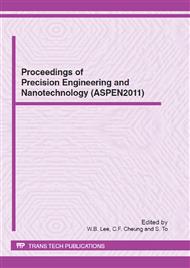p.240
p.245
p.251
p.257
p.263
p.269
p.275
p.281
p.287
Study of Metals by Femtosecond Laser Processing for Electro-Optics Applications
Abstract:
Femtosecond laser (FS-laser) microstructuring of metals has become a promising tool because of its non-contact nature, which allows the micromachining and direct processing of materials with a minimized volume of heat-affected zone for electro-optics applications such as light emitting diodes (LED) and solar photovoltaic (PV) lighting. This study presents ultra-short pulse (10-15 sec) FS-laser processing. Through integrating the laser source, optical system and dynamic control modules, the materials of metals with micro-scale or nanoscale structures can be fabricated. In traditional processing such as semiconductor processing, development, exposure and etching necessitate expensive equipment and time-consuming tasks. With FS-laser processing, high-precision patterns are obtained, which will be a great benefit to keeping costs down. In this study, the wavelengths of FS-laser ablation are employed using visible and infrared light. To make a breakthrough in electro-optics processes, the CIGS thin-film of solar cells in metal process can be easily produced by the FS-laser. The ablation speed of the FS-laser for thin film layer CIGS solar cells can reach 2000 mm/s which is faster than the current Nd:YAG laser machine (~1000 mm/s). On the other hand, the minimum size of metal lines can be controlled to a value that is lower than 40 µm. Furthermore, green energy can be effectively developed for the future.
Info:
Periodical:
Pages:
263-268
Citation:
Online since:
June 2012
Keywords:
Price:
Сopyright:
© 2012 Trans Tech Publications Ltd. All Rights Reserved
Share:
Citation:


